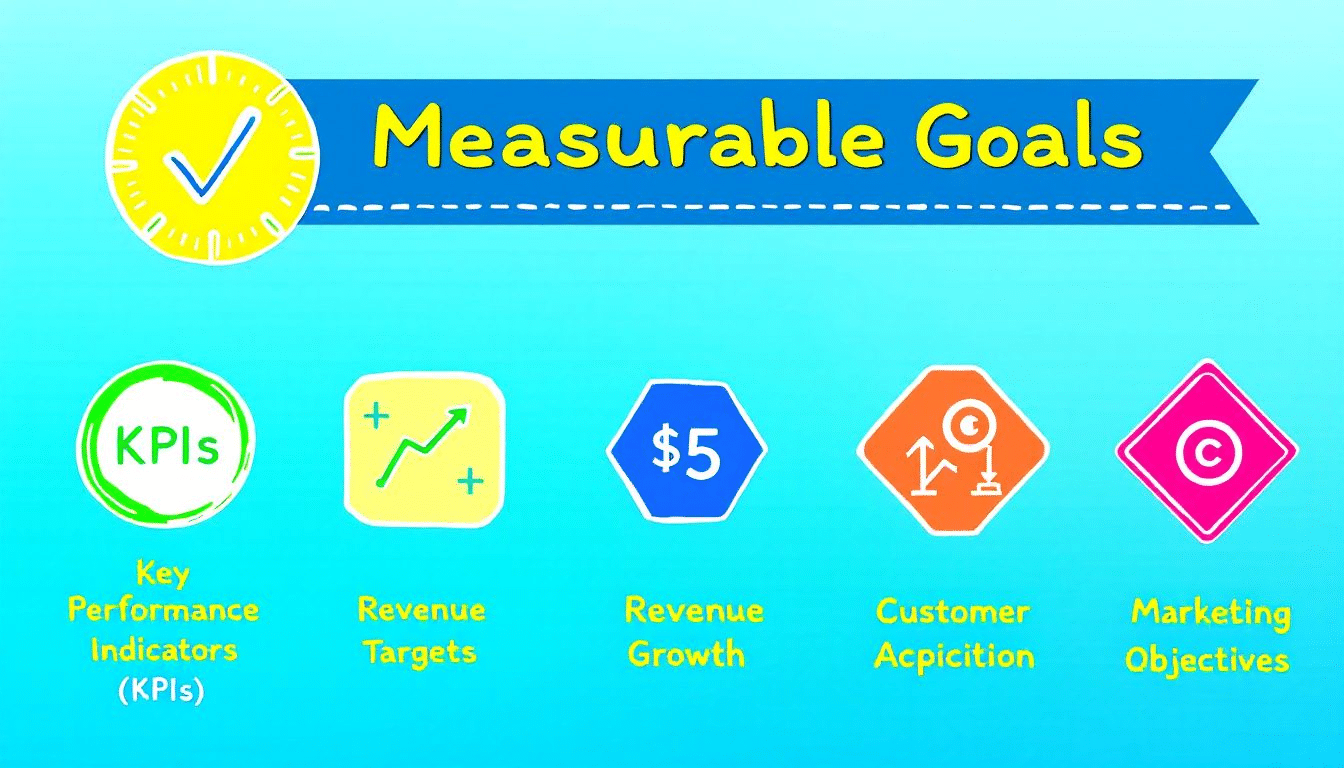The ‘M’ in SMART goals stands for ‘Measurable.’ This means that your goals should have clear criteria for tracking progress. By setting measurable goals, you can easily monitor your advancements, stay motivated, and make necessary adjustments. In this context, you might wonder, what does the m in smart goals stand for? This article explores the importance of measurable goals and how to set them effectively within the SMART framework.
Key Takeaways
-
SMART goals provide a structured approach to goal-setting by ensuring objectives are Specific, Measurable, Achievable, Relevant, and Time-bound.
🎯 Ready to Transform Your Results?
Get the complete system that hundreds have used to achieve breakthrough results.
Get the Book for $7 -
The ‘M’ in SMART stands for Measurable, emphasizing the importance of quantifiable metrics to track progress and stay motivated.
-
Setting clear, measurable goals and benchmarks enhances accountability and helps maintain focus, ultimately driving performance and achieving objectives.
Understanding SMART Goals

SMART goals utilize a structured set of criteria that ensure objectives are well-defined and achievable within a specified time period. A smart acronym represents five key criteria. These are Specific, Measurable, Achievable, Relevant, and Time-bound. Each element plays a pivotal role in effective goal setting, providing a clear roadmap from the initial idea to the final achievement.
Specific goals remove ambiguity and provide a clear direction. Measurable goals help you keep track of your progress. They also play a vital role in maintaining your motivation. Achievable goals confirm that your defined objectives are realistic given the resources and time available. Relevant goals align with your broader objectives, ensuring that your efforts contribute to long-term success. Lastly, Time-bound goals set a deadline, creating a sense of urgency and helping to prioritize tasks.
Setting SMART goals brings clarity, focus, and motivation, aiding in project management and enhancing employee motivation by aligning efforts with business objectives. Here, we explore the ‘Measurable’ aspect, its significance, and implementation strategies.
Defining Measurable in SMART Goals
The ‘M’ in SMART goals stands for Measurable, meaning goals should be quantifiable for effective tracking. Achieving a goal without knowing your progress is like driving without a map—movement without direction.
Measurable goals need evidence that can be tracked. A measurable goal with clear criteria shows how far you’ve come and what remains to be done.
Clearly defined SMART goals offer a solid foundation for measurement and align with broader objectives to prevent wasted effort, leading to smarter goals.
Importance of Measurable Goals
Measurable goals enhance clarity and accountability. When everyone understands the objectives and measurement criteria, it removes ambiguity and aligns efforts towards a common goal, boosting engagement and performance.
A common mistake is setting unclear goals, leading to misinterpretation and inefficiency. Measurable goals support tracking progress, maintain motivation, and refine strategies. Regular progress measurement allows for timely adjustments and staying on course.
Characteristics of Measurable Goals
Quantifiable metrics are crucial for measurable goals, including numerical targets, percentages, or specific milestones. Performance metrics, such as revenue, customer acquisition cost, and employee engagement levels, are examples.
Common goal-setting mistakes include lack of specificity and measurable criteria. Measurable goals need specific criteria for tracking progress. Clear, quantifiable targets make success and its achievement clear to everyone.
How to Make Your Goals Measurable
To make goals measurable, break them into specific, trackable components. Instead of a vague goal like “improve sales,” aim to “increase sales by 20% over the next quarter.” This provides a clear target and timeframe, easing progress tracking and strategy adjustments.
An impactful goal measurable includes measurable, trackable benchmarks. Adding numbers or parameters ensures goals are actionable plans, not just dreams. Clear metrics are crucial for tracking progress, often overlooked by many.
Without deadlines, goals can extend indefinitely, leading to stagnation. A well-structured SMART goal statement outlines the expected outcome, target date, and responsible parties clearly.
Setting Quantifiable Metrics
Metrics like ‘how much’ or ‘how many’ are essential for measurable goals. Instead of “improve fitness,” set a target like “train to run a half marathon in under two hours.” Specificity avoids miscommunication and confusion.
Precise objectives prevent ineffective strategies. Realistic goals should consider current necessary resources, time constraints, and individual capabilities to maintain motivation. Quantifiable metrics provide a tangible way to track progress and celebrate achievements.
Establishing Clear Benchmarks
Effective benchmarking compares performance against established standards or previous results. For example, a business might implement three new marketing campaigns each year, providing a clear path for tracking progress and making adjustments.
Set benchmarks by defining realistic standards for success aligned with desired outcomes. Clear benchmarks ensure everyone knows the criteria for success and can track progress effectively.
Benefits of Measurable Goals

Measurable goals enhance motivation by providing clear targets and visualizing progress. Seeing your progress keeps you motivated and focused. They also facilitate better progress tracking with clear metrics and timelines.
SMART goals optimize resource allocation by highlighting misalignments and establishing standardized benchmarks, using smart criteria within a smart framework. This directs efforts towards impactful activities, maximizing efficiency and effectiveness through smart goal setting and smart objective.
Tracking Progress Effectively
Measurable goals act as a roadmap, guiding performance and aiding in progress evaluation. They allow for tracking and accountability. Periodic progress measurement towards SMART goals prevents missing goals by enabling course correction.
Clear benchmarks offer objective criteria for evaluating progress, simplifying identification of areas needing improvement. Regular updates and monitoring allow for timely strategy adjustments. Regular goal reviews help identify obstacles and adjust strategies as needed.
Boosting Motivation
Achievable and relevant goals boost morale, enhancing team spirit and drive. Celebrating small achievements maintains enthusiasm for ongoing relevant goal.
Achievable goals combined with recognition of small victories foster motivation, leading to greater engagement and productivity. When everyone is motivated and aligned, achieving long-term goals becomes more likely.
Common Pitfalls to Avoid with Measurable Goals
A common error in the goal setting process is creating goals dependent on factors outside your control. Avoiding such goals is crucial for maintaining accountability.
Set goals you can directly influence to ensure progress and success.
Avoiding Vague Metrics
Vague metrics lead to confusion in tracking progress. Effective goal-setting requires specific, easily understood metrics. Without clear metrics, the meaning of success can vary widely among individuals.
Creating precise metrics involves specific, quantifiable criteria for clear tracking. Benchmarks provide reference points for measuring progress and success. Utilizing feedback and adjusting metrics as needed ensures they remain relevant and actionable.
Ensuring Realistic Measurements
Unrealistic goals demoralize teams and cause project delays. Realistic evaluation based on experience and qualifications is crucial for ambitious goals. Setting realistic goals is essential for effective measurement.
Aligning goal realistic with metrics ensures achievable progress and maintains motivation. Realistic, attainable goals keep momentum and help achieve objectives without unnecessary setbacks.
Examples of Measurable Goals

Nonprofits could aim to boost active volunteers by 40% within two years or increase website traffic by 30% within a year using SEO strategies. Measurable goals quantify objectives, simplifying progress and outcome tracking.
Measurable goals are crucial for organizations to understand progress and make data-driven decisions. Here are practical examples of measurable goals, showing how discussed concepts apply in real life.
Business Goal Example

A company might aim to acquire 30% more donors in a year by refining its donation page. Increasing social media followers by 25% within six months can be tracked through analytics tools. Producing three different types of large-scale marketing assets per month for Q1 is another example.
Measurable business goals are essential for tracking progress and ensuring accountability. Clear, quantifiable targets enable effective progress monitoring and data-driven decision making.
Personal Development Goal Example

Train to complete the San Diego half marathon with a finish time under two hours. Aim to generate 1,000 new Instagram followers using specific hashtags. Measurable personal development goals are specific targets for improving skills or achieving milestones.
Measurable goals also apply to social media growth and presence. Clear, quantifiable targets help individuals track progress and achieve personal and professional goals.
Summary
Summarizing the key points discussed, measurable goals are an essential component of the SMART framework. They enhance clarity, motivation, and accountability, making it easier to track progress and achieve objectives. By setting measurable goals, you can stay motivated, make data-driven decisions, and ultimately achieve your long-term goals.
FAQ
What does the ‘M’ in SMART goals stand for?
The ‘M’ in SMART goals stands for ‘Measurable’, meaning your goals should be quantifiable to easily track your progress. Embrace this step, and you’ll see how much closer you can get to achieving your dreams!
Why are measurable goals important?
Measurable goals are crucial because they provide clarity, hold you accountable, and boost your motivation by allowing you to track progress effectively. Embrace them to refine your strategies and achieve your aspirations!
How can I make my goals measurable?
To make your goals measurable, set specific numbers or percentages and define clear benchmarks for success. This will help you track your progress effectively!
What are common pitfalls to avoid when setting measurable goals?
To achieve your goals successfully, steer clear of vague metrics; instead, set clear and realistic measurements that align with your resources and capabilities. Keep it precise, and watch your progress soar!
Can you give an example of a measurable goal?
A great example of a measurable goal is to increase your social media followers by 25% within six months. This keeps you focused and allows for clear tracking of your progress!
